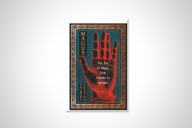You have /5 articles left.
Sign up for a free account or log in.
Last month, a little bird told me that MIT Press was celebrating its 30th year with Roger Conover as executive editor. One day soon -- if we haven't reached that point already --the idea of anyone remaining at a single position for three decades (especially in the challenging field of academic publishing) will sound only slightly more credible than the mortality data recorded in the fifth chapter of Genesis .
But that wasn't what made me want to interview Conover on the occasion of this anniversary. In this reader's opinion, MIT Press produces some of the most interesting and visually appealing books to appear from an academic publisher each season. It stood to reason that the executive editor would have something to do with that.
Conover answered my questions by e-mail, assembled here into an interview. Given that the exchange took place amidst the usual chaos of holiday travel, we only had time for three rounds. But the discussion was plenty broad -- art, architecture, Cold War sensibility, Slovenian punk rock, and nuclear submarines, among other topics.
Q:Around the time you were joining MIT Press, I was a teenage science nerd. Whatever MIT books came my way then tended (if memory serves) to be titles on mathematics and computer science. Was that just a matter of being stuck in one part of the library? When did the emphasis on the visual arts begin? Were books in the arts and the humanities published by MIT Press before you started there?
A: MIT Press had a boutique list in architecture and design going back to the 1960s. This came about largely as a result of Muriel Cooper, the first art director of MIT Press and also the designer of our logo. Muriel was a pioneer in computational design and information graphics; she had already founded MIT's design services department, and would go on to found its Visible Language Workshop, a dynamic laboratory of interactive design within MIT's Media Lab. Some of the cornerstones of MIT's architecture list were in place before I got there.
I am convinced that Muriel's design had a lot to do with attracting authors like Robert Venturi, Herbert Muschamp, and Richard Saul Wurman to MIT Press in the first place. When you think of books like Hans Wingler's Bauhaus, Robert Venturi's and Denise Scott Brown's Learning from Las Vegas, Kevin Lynch's Image of the City and Site Planning, Paolo Portoghesi's Roma Barocca, and Steen Rasmussen's Experiencing Architecture, you get a sense that there was something pretty special going on here in the 1960s and 70s.
These are the books that attracted me to MIT Press, and Muriel was the person I worked with most closely when I first got there. We were natural allies, as I had come to MIT Press from the Architects' Collaborative, the firm that Walter Gropius had founded when he left the Bauhaus to teach at Harvard's Graduate School of Design. MIT Press had already published several books by Bauhaus authors before I arrived -- Walter Gropius, Moholy-Nagy, and Josef Albers were all on the list. When the Bauhaus teachers left Germany and took up positions at places like Black Mountain, Yale, and Harvard, they needed a publisher, and MIT Press was the first one to pick up their work.
That was the part of MIT Press that I knew, and identified with, in the 1970s. So while my picture of the way things were at MIT Press in the 60s and 70s is not quite the same as yours, it's also true that those early architecture and design books were not part of any systematic acquisition program. I was the first editor MIT Press hired to develop a formal program in the visual arts, but I definitely was able to build on strengths that were already there, and to attract visual-minded authors because of the press's strong design department. In terms of my activities, architecture and design came first. Art and photography came later.
I think it's fair to say that MIT Press was the first university press to make a serious commitment to graphic design, as well as to architectural publishing. Thirty years later, there are more players, but the depth and longevity of MIT Press's commitment to design publishing and practice remains quite exceptional.
Q:Over the past few years, you've started publishing books by Slavoj ZIzek and his circle -- including a very interesting study of Neue Slowenische Kunst, the avant garde movement of which Zizek was, at one point, a kind of fellow traveler. (The rock band Laibach was also part of NSK.) I've heard that you had contact with this milieu for some time. How did that come about?
A: My response to that has more to do with ideas, politics, and place than people. My interest in the things you're asking about actually predates those references by quite a bit. I first went to East Berlin as a teenager -- on one of those "don't talk to anyone in the streets and be back in your hotel by dark" passes -- part of a 1960s cultural exchange program sponsored by a YMCA boys' camp, which I now understand was part of an American Cold War youth propaganda initiative.
Passing through Checkpoint Charlie and disappearing into the grey streets of Berlin was like stepping through a one-way mirror and looking back at your own world from the other side of paranoia. This was obviously long before I had ever heard of "hauntology," or read Derrida's Spectres of Marx, and it was also a long time before I would see the defensive bunkers that Enver Hoxha had erected all along the arid "Albanian Riviera"--the perfect reverse imaginary of our East-bearing submarines. But this experience was perhaps my first inkling of what theory was for, and of how writers like Andrei Codrescu and Slavoj Zizek, and artists like Mladen Stilinovic and the Irwin group, would later matter to me.
But I'd like to go back even further, to explain how Eastern Europe first insinuated itself as an idea and a desire. Growing up outside of New London, Connecticut, the home of the U.S. submarine base, the Millstone power plant, General Dynamics Electric Boat, Pfizer, the Coast Guard Academy, and the Underwater Sound Lab, I was raised on the fantasy that when the Russians attacked, we would be the first target after the Pentagon. This was always mentioned with a kind of pride, as a point of honor: New London County was of concern to the Kremlin.
I don't remember exactly when I figured out that the bomb was probably not going to be dropped on us, but I know that I registered that realization with mixed feelings. There was an element of letdown as well as relief in reprieve. So much thought and investment had gone into the preparation. The idea of that my best friend's basement, which had been made into a bomb shelter, was never going to be used -- it seemed a waste.
And all those class trips on the nuclear subs -- didn't the sailors have better things to do than show their missiles to us schoolkids? When the sirens blasted, did it always have to be just another air raid drill? And all those practical toys we had grown up with: ham radios, periscopes, gas masks, Atomic Disintegrator cap pistols -- weren't we ever going to be able to show the enemy we knew how to use them?
In a more serious sense, I think the long-deferred assault of post-Stalinist firepower on American space, the long-anticipated invasion, has finally begun to take place, and that the books you refer to are one of the manifestations. I guess you could say that my wish finally produced something; or, as Zizek would say, that I am finally enjoying my long-festering symptom.
In the late 1980s and early 1990s, I started traveling intensely through the countries that were fast on their way to becoming the former Communist bloc. I wanted to meet the artists, writers, and philosophers whose work had influenced the political changes that were taking place, and whose projects had had so much to do with critiquing a system that was now being replaced. Some of these individuals and groups were already beginning to look critically at another system, one that was still new to them, and that they had not had much experience with, but that their training and instincts equipped them to view with strategic distance -- the Western art market and global capital economy.
I was also interested in Collectivity -- how it functioned both as a social reality and as artistic practice. And yes, one of the art collectives I came in contact with early on was NSK. I first heard about them from Obrad Savic, a Serbian philosopher who was very active in anti-Milosevic, anti-Serbian nationalist circles, and one of the founders of the Belgrade Circle. I had met Savic on one of his lecture trips to the US, and when he heard I was going to former Yugoslavia, he hooked me up with some of his philosopher and artist friends in places like Sarajevo, Ljubljana, Belgrade, Pristina, Skopje, and Zagreb.
That's how I first met NSK, and first heard of Slavoj Zizek. You are right that Zizek came out of the same milieu. When he published his first book with MIT Press in 1991 ( Looking Awry), he was just another Slovenian philosopher. His biggest claim to fame in those days was that he had made a bid for (and lost) the presidency of Slovenia in 1990.
Q:Would you please discuss the MIT's history with October? For readers who aren't familiar with it, the best way to describe the journal would be to call it the switching center where cultural theory and the art world cross paths. But there's something rather severe about its design and inscruitible about its functioning. (If somebody published a memoir about how the inside of that particular Kremlin operated, I'd definitely want to read it.) How did it come to MIT Press? And how has it being there influenced your acquisitions?
A: The history has a history. If you look at the first four issues of October, you will see a largely forgotten detail. On the copyright page it says: "published by the Institute for Architecture and Urban Studies, and distributed by Jaap Rietman."
Jaap Rietman was a bookseller in NYC, and a friend of Rosalind Krauss and Annette Michelson, two of the founding editors. (Trivia question: Who was the third founding editor, now an L.A. based artist and critic? Non-trivia question, for the memoir you want to read: who was Jeremy Gilbert-Rolfe, and why did he leave after three issues?).
Anyway, "distribution by Jaap Reitman" meant Jaap sold the journal in his store in Soho, Manhattan. But "published by the IAUS" meant something else. The IAUS was the architectural discourse laboratory co-founded by Peter Eisenman, Kenneth Frampton, and Mario Gandelsonas in 1972; they were also the founding editors of its house organ, Oppositions, a journal of largely European neorationalist and modernist tendencies devoted to the theory and criticism of architecture. Oppositions was initially published by Wittenborn; in 1976, it moved over to MIT Press.
A few years later, we launched a series of books giving fuller play to the ideas and writers introduced in the journal. Oppositions Books was the model and the precedent for October Books, the series we later launched, and still co-publish, with October. The IAUS was one of the places I cut my editorial teeth; I was initially hired to acquire architecture books for MIT Press, and there no was better place to meet the players, hear the voices, and listen to architectural ideas being debated in those days than the IAUS.
I met many people there whom I would later publish, or work with, many of whom are still collaborators. Rosalind Krauss was one of them. I met her in 1977; at that time, the IAUS was still October's institutional host, but a year later, Oppositions and October were both being published by MIT Press. Krauss was already an MIT Press author at that time. Terminal Iron Works: The Sculpture of David Smith was published by MIT in 1971 (Krauss taught art history at MIT from 1967-1971).
In 1984, the IAUS, Oppositions, and Oppositions Books abruptly folded. But the intellectual force that Oppositions exerted soon led Michael Hays to launch a new journal, Assemblage; Assemblage ran for another 10 years; then it elegantly suicided, announcing its intention to do so, and giving its reasons in advance. Basically, Michael had accomplished what he set out to. It was time for a new generation to take over. Out of Assemblage's editorial ashes rose Grey Room.
Oppositions has been gone for almost 25 years now, but it still acts as an intergenerational force and intellectual spark in a way that many living journals do not. Oppositions went 26 issues. October is now up to 122. In their founding editorial, October's editors referred to "a number of isolated and archaic enterprises" that had "sustained a division between critical discourse and significant artistic practice" [and had] "encouraged the growth of a new philistinism within the intellectual community."
Citing Partisan Review as one of their negative examples, October's editors set their course: " October's strong theoretical emphasis will be mediated by its consideration of present artistic practice." Partisan Review, the journal that began by advocating the culturally revolutionary values of modernism and holding up Trotsky as a redemptive model for American proletariat culture, petered on for another 20 years. By the time it was officially put to rest in 2003, it had become the enemy it had once warned its readers against -- one more voice of neoconservatism defending "standards" in art and culture. It's necessary to think critically about duration, especially if you are a journal, the very idea of which is time-based. Journals, by definition, are about being replaced.
October's founding editors were breakaway editors from Artforum, and breakaway thinkers from their elders. I am glad that October is part of my professional history. I have learned a great deal from that project. The way I became aware of it -- through architecture -- is what first led me to start acquiring books in art -- through architecture. I wouldn't say, beyond that, that my list has much to do with their politic. Their editorial exercise is rigorous, and it is one of the things that challenges me to stay fit. I know I feel an obligation and desire to work some art muscles that they don't, especially because we are perceived to work out of the same gym, the MIT gym. It would not be good for the field if our games were the same, and if there was no tension in the relationship.
I am very aware that observations like yours -- putting Kremlin next to their name -- are becoming more frequent, and are meant to raise questions about power and practice. I can also imagine that it's flattering to be called the Kremlin when you are just the old administration. Personally, I hope I am knocked out of the ring by a young buck or have the sense to get out long before I am offered such compliments.








